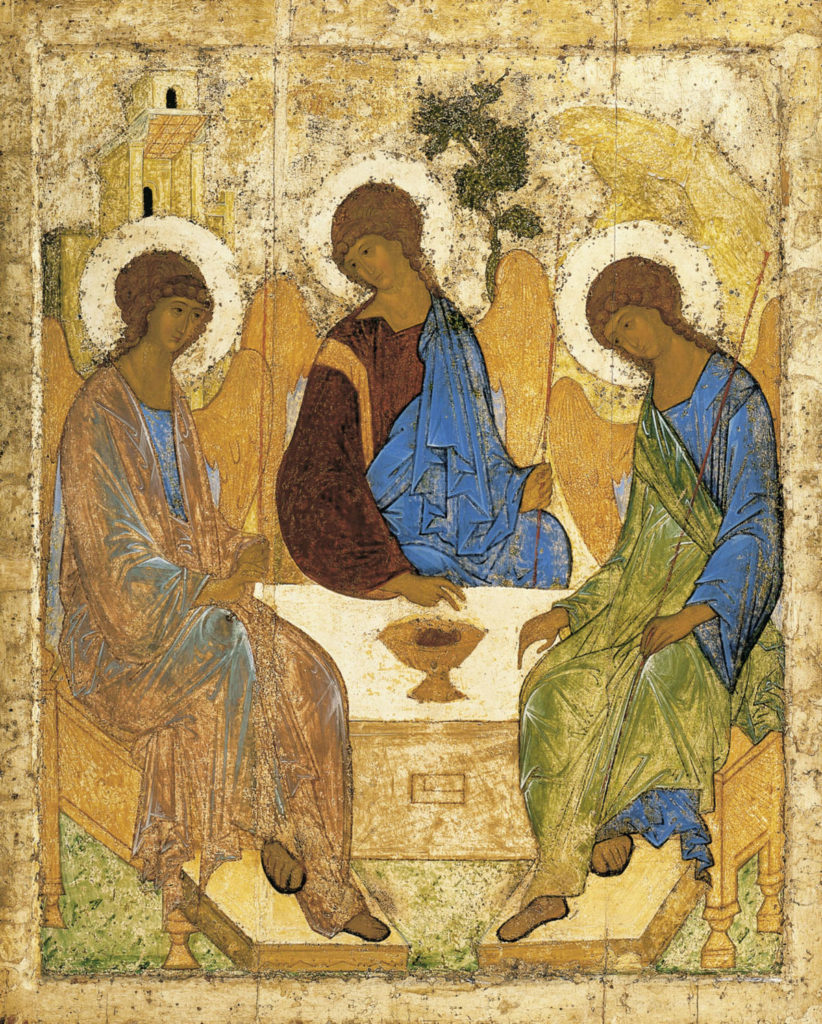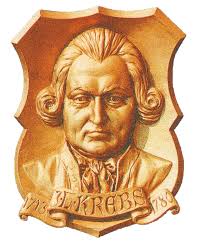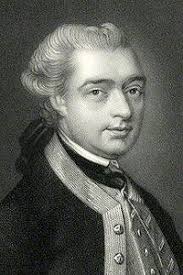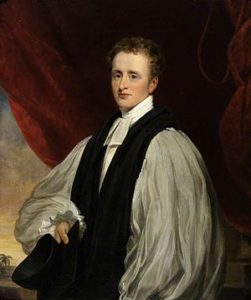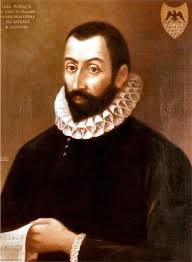The Trinity, by St. Andrei Rublev
Mount Calvary Church
Eutaw Street and Madison Avenue
Baltimore, Maryland
A Roman Catholic Parish
The Ordinariate of the Chair of St. Peter
Rev. Albert Scharbach, Pastor
Trinity Sunday
8:00 Said Mass
10:00 Sung Mass
_________________________________________
Prelude
Wir glauben all’ an einen Gott, Johann Ludwig Krebs
Hymns
Come, thou almighty King (MOSCOW)
Come, risen Lord, and deign to be our guest (SURSUM CORDA)
Holy, holy, holy, Lord God almighty (NICAEA)
Anthems
Te Deum Patrem ingentem, Luca Marenzio
Benedicta sit Sancta Trinitas, Palestrina
Postlude
Allein Gott in der Höh’ , J.S. Bach
____________________
PRELUDE
Wir glauben all’ an einen Gott, Johann Ludwig Krebs
Here is Ulrike Theresia Wegele on Gabler-Orgel of the Basilica in Weingarten.
Johann Ludwig Krebs (1713-1780) was a composer whose career spanned the end of the Baroque and beginning of the Classical era. In many respects, it typifies the problems many musicians had in coping with the drastic change of style this implies. Since he was an exceptionally skilled writer of counterpoint, he might have ended up with considerably wider fame if he had been born 20 years earlier.
From 1726 to 1735 Johann Ludwig Krebs was enrolled at the Thomasschule in Leipzig, where J.S. Bach was Kantor. While in Leipzig, J.L. Krebs was one of J.S. Bach’s private keyboard pupils, and from 1729 to 1731 he copied performing parts for various church cantatas by J.S. Bach. Bach held him in high regard, punning on both their names (Krebs [crab or crayfish] and Bach [brook or stream]) by saying “He is the only crayfish in my stream.” It is not surprising that many of his works, especially his organ compositions, are very much like those of J.S. Bach.
_________________________________________
HYMNS
Come, Thou almighty King (MOSCOW)
Come, thou almighty King by the prolific composer anonymous dates from before 1757, when it was published in a leaflet and bound into the 1757 edition of George Whitefield’s Collection of Hymns for Social Worship. The text appears to be patterned after the British national anthem, God Save the King.
At first, this hymn was sung to the same tune as “God Save the King.” On the American side of the Atlantic, we use the same tune for “My Country ‘Tis of Thee.”
Supposedly during the American Revolution, while British troops were occupying New York City and appeared to be winning the war, a group of English soldiers went to church one Sunday morning in Long Island. The setting was tense. The occupiers demanded the congregation sing, “God Save The King” in honor of King George III. The organist was forced to begin playing the tune – but instead of singing “God Save the King,” the congregation broke out in “Come, Thou Almighty King.”
Here is a lively version, which you probably will never see at Mount Calvary, although it would get the attention of the children. Here are somewhat more subdued Presbyterians. Here is a Baptist megachurch version. Here are the Corban University Chamber Orchestra, Concert Band and Concert Choir in a somewhat Hollywood take on the hymn. Let us give thanks for Mount Calvary.
The tune is MOSCOW by Felice Giardini (1716-1796). He was a chorister in Milan Cathedral and was a pupil of Paldini before studying the violin under G. B. Somis. It was as a violinist that he became well known, both as an orchestral player and a soloist, particularly for his prowess as an embellisher of melody. After a period at the Teatro San Carlo in Naples, he travelled throughout Germany and France before arriving in London where, according to Charles Burney, he made his first appearance in May 1750. His first successes were immense, but he later suffered severe financial losses with the Italian Opera whose management he had undertaken in 1756. Returning to the violin to make his living he played in orchestras all around Britain, notably at the Three Choirs Festival (1770-76), and in London he played for the Pantheon Concerts (1774-80) and again for the Italian Opera (1782-83). Facing greater competition in from figures such as Wilhelm Cramer and Salomon, Giardini was able nevertheless to preserve his position in London, but by 1784 he had grown embittered and quarrelsome. On leaving London in that year he lived in Naples, intending to retire from public music-making; but always restive in temperament, he came back to London in 1790 as a harpsichordist, where he promoted comic opera at the Haymarket. This was a failure, and so he took his troupe to Moscow where he died in 1796 in a state, apparently, of acute poverty and distress.
____________________
Come, risen Lord, and deign to be our guest (SURSUM CORDA)
Come, risen Lord, and deign to be our guest, by George Wallace Briggs, celebrates the presence of Christ in the Lord’s Supper. It is unusual in its opening, which begins conventionally enough, inviting Christ to be present, and then skilfully rejects that first line (with ‘Nay’) in favour of a deeper and more significant meaning. Stanzas 1 and 4 allude to the part of the Emmaus story (Luke 24:28-35) in which the two disciples invite Jesus to be their guest, but then Jesus becomes their host. Stanza 2 focuses on our partaking of the sacrament and stanzas 3 and 4 on the oneness we share with all believers in this world and in heaven.
Here is the St. Andrew’s Choir.
Briggs was a Canon of Worcester Cathedral and a distinguished British hymn writers and hymnologist. Six of his hymns appear in the Episcopal Hymnal of 1940. He was the author of one of the prayers used at the time of the famous meeting of Churchill and Roosevelt on H.M.S. Prince of Wales in 1941 when the Atlantic Charter was framed.
The tune SURSUM CORDA is by Alfred Morton Smith (1879-1971). He was born in Jenkintown, Pennsylvania, and studied at the University of Pennsylvania (B.S. 1901) and Philadelphia Divinity School (B.D. 1905; S.T.B. 1911). An Episcopalian, Smith was ordained a deacon (1905) and a priest (1906). After a short time in Philadelphia and Long Beach, California, he served at St. Matthias Church, Los Angeles, for ten years. He was a chaplain in the U.S. Army during World War I, returning to Philadelphia in 1919, where he spent the remainder of his career. He retired in 1955. In 1963, Smith moved to Drium Moir, Chestnut Hill, Pennsylvania, and in 1968 to Brigantine, New Jersey, where he remained until his death.
____________________
Holy, holy, holy, Lord God almighty (NICAEA)
Holy, holy, holy, Lord God almighty is by Reginald Heber. This is the best known of Heber’s hymns, written for Trinity Sunday. It was first published in A Selection of Psalms and Hymns for the Parish Church of Banbury (Third Edition, 1826) and subsequently in Hymns written and adapted to the Weekly Church Service of the Year (1827), published after his death.
It is a reverent and faithful paraphrase of Revelation 4:8-11 and John’s vision of the unceasing worship in heaven: as such, it is a fine example of Heber’s care to avoid the charge of excessive subjectivity or cheap emotionalism in his hymns, and so to win support for the use of hymns in worship within the Anglican Church. Beginning with the thrice repeated ‘Holy’, it proceeds to find images for the Holy Trinity that attempt to capture its elusive magnificence. Particularly notable is ‘though the darkness hide Thee’, which expresses the awareness of God in mystical terms through the via negativa.
The hymn was a particular favourite of Tennyson’s, who told Bishop Welldon that he thought it the finest hymn ever written, considering the difficulty of the subject and the devotion and purity of its diction. It was sung at Tennyson’s funeral in Westminster Abbey.
Here are the Mormons singing it, with significant alterations in the text: Deity instead of Trinity. And here are the Presbyterians with the orthodox version.
Reginald Heber, D.D. (1783—1826). His father was rector of Malpas and squire of Hodnet, Cheshire. He was educated at Whitchurch Grammar School, privately at Neasden, and at Brasenose College, Oxford, where he won the Newdigate Prize for his poem ‘Palestine’ (later set to music by William Crotch) in 1803. He was elected a Fellow of All Souls College in 1805, and after travelling in several countries including Norway, Sweden and Russia, he was ordained (1807). He was vicar (and lord of the manor) of Hodnet, Shropshire, 1807-23, during which time he wrote his hymns. He was also Bampton Lecturer at Oxford and preacher at Lincoln’s Inn; editor of The Whole Works of Jeremy Taylor; and one of the original staff of the Quarterly Review as a friend and fellow-contributor with Scott* and Southey.
After some hesitation, he agreed to be consecrated Bishop of Calcutta in June 1823, arriving in India in October of that year. His see covered all of British India and he pursued a caring and energetic episcopate, sometimes hindered by fever but travelling widely through all parts of India and Ceylon (Sri Lanka). He founded Bishop’s College, Calcutta, and ordained the first Indian to take Anglican orders. After confirming forty-two people at Trichinopoly, South India, he died suddenly of a seizure while bathing. He was seen as an heroic martyr in the cause of missionary work, and his example was an inspiration to many others in the 19th century.
His position as a highly-regarded figure helped to dispel the idea that hymns were associated with Methodists and extreme Evangelicals. His hymns are those of a poet of the Romantic period.
The tune NICAEA is by John Bacchus Dykes (1823-1876). A graduate of Cambridge, where he was very active in music, he became precentor at Durham, where he established choir discipline (the choir was reckoned to be one of the finest in England under his stewardship) and proper dress (which included cassocks and surplices). He then became vicar of St Oswald’s where he was involved in a number of controversies.
As a high churchman he embraced the ‘consubstantial’ view of the Eucharist (rather than the ‘transubstantiation’ of Wilberforce), a sacrament he promoted with alacrity at St Oswald’s; and he felt a kinship with Keble’s teachings on the early church (rather than Newman’s understanding of the doctrine of the church). He resisted attacks on the low-church evangelicals and dissenters but, during the controversy on the writings of Bishop Colenso, called unequivocally for his deposition. Perhaps the saddest episode of his ministry was in his last years at St Oswald’s when he entered into a dispute with the Bishop of Durham (Baring) in 1873. Forbidden to wear coloured stoles and to turn eastwards during the celebration of Communion, Dykes considered this an unreasonable attack on high churchmen and ritualistic practices in the Durham diocese. With numerous allies, he defied his Bishop, who refused to license further curates to St Oswald’s. An appeal to the Court of the Queen’s Bench was made in January 1874, but, not wishing to interfere in ecclesiastical matters, the judges dismissed Dykes’s case. He was much disappointed by this ruling and published an open letter to Baring, Eucharistic Truth and Ritual, in August 1874. About the same time, Alfred Curtis, rector of Mount Calvary, was engaged in a similar battle with Bishop Whittingham of Maryland.
______________________________________________
ANTHEMS
Te Deum Patrem ingenitum, Luca Marenzio
Te Deum Patrem ingenitum,
te Filium unigenitum,
te Spiritum Sanctum Paraclitum,
Sanctam et individuam Trinitatem,
toto corde et ore confitemur,
laudamus, atque benedicimus:
tibi gloria in saecula.
Thou, God the unbegotten Father,
thou, the only begotten Son,
and thou Holy Spirit, the Comforter,
the holy and undivided Trinity,
with all our heart and mouths we confess thee,
we praise thee, and bless thee;
to thee be glory for ever.
Here is the Progetto Musica.
Italian composer and singer Luca Marenzio (ca. 1553-1599) was considered by many Renaissance musicians to be the chief archetype of the expressive 16th-century Italian madrigal style. This anthem is from his Motectorum Pro Festis Totius Anni, 1585
_________________________________
Benedicta sit sancta Trinitas, Giovanni Pierluigi da Palestrina (1525-1594)
Benedicta sit sancta Trinitas
atque indivisa Unitas
confitebimur ei quia
fecit nobiscum misericordiam suam. Alleluia.
Benedicamus Patrem et Filium
cum Sancto Spiritu.
Blessed be the holy Trinity,
and undivided Unity:
we will give glory to Him,
because He hath shown His mercy to us. Alleluia.
We bless the Father and the Son
with the Holy Spirit.
Here it is from Puebla, Mexico.
_________________________________
Postlude
Allein Gott in der Höh’ , J. S. Bach
Here is Daniel Bruun, who looks to be about fifteen years old.
